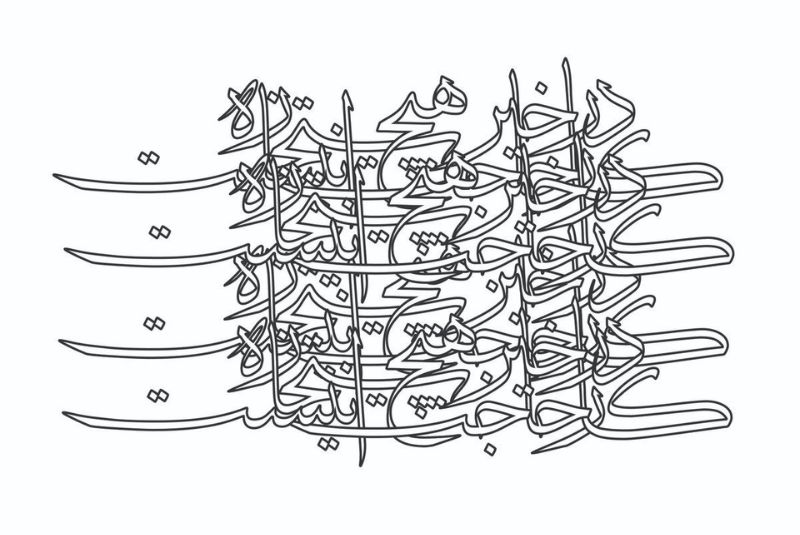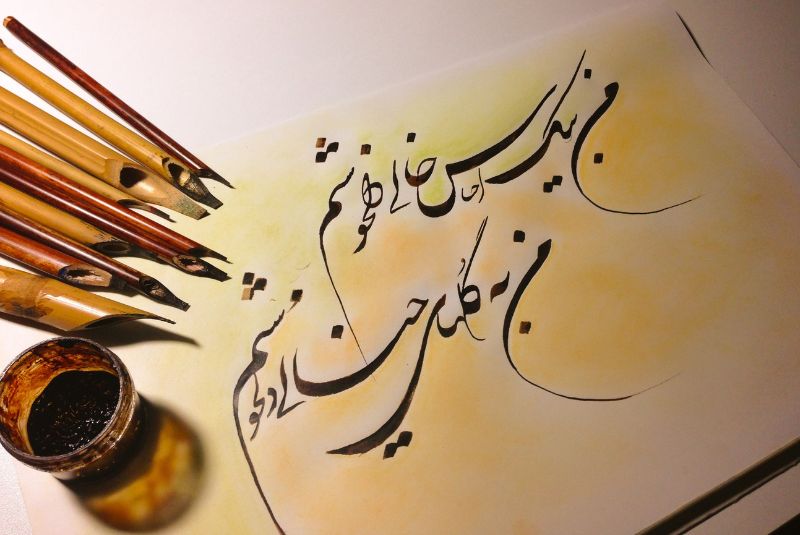Persian Calligraphy: From Qalam to Masterpiece
Persian Calligraphy, also known as "Khatt-e Parsi" or "خط ایرانی" in Farsi, is a revered and intricate art form that has been an integral part of Persian culture for centuries.
It is a form of artistic expression that uses the written word to create visually captivating compositions, transcending mere communication and evolving into a profound medium of artistic expression.
Its intricate beauty and deep-rooted cultural significance make it an art form deeply revered by Persians and admired worldwide. In this comprehensive guide to Persian Calligraphy, we aim to take you on a journey through the history, styles, techniques, and cultural significance of this captivating art form.
Origins of Persian Calligraphy
Persian Calligraphy traces its roots to ancient Persia, with its origins dating back to the pre-Islamic era. During this time, Persian scholars developed scripts to transcribe important texts, paving the way for the evolution of calligraphy as an art form. The influence of various cultures, including Arabic, Chinese, and Greek, played a role in shaping Persian Calligraphy, resulting in its unique fusion of styles and scripts.
The evolution of Persian Calligraphy can be divided into several key eras, each marked by distinct developments and innovations. These include:
- Early Persian Calligraphy: The development of Persian scripts, such as Pahlavi and Avestan, in ancient Persia.
- Islamic Golden Age: The spread of Islam introduced Arabic script to Persia, leading to the fusion of Arabic and Persian calligraphy styles. The advent of the Persian script, Nasta'liq, in the 14th century was a significant milestone.
- Safavid Dynasty: The Safavid rulers of Persia in the 16th century were patrons of the arts, which led to the flourishing of calligraphy as a form of artistic expression.
- Qajar Period: This era witnessed the refinement of Nasta'liq script and the emergence of Shekasteh Nasta'liq, characterized by its cursive and fluid style.
Throughout these periods, Persian Calligraphy continued to evolve, incorporating new styles, scripts, and techniques, contributing to its rich and diverse heritage.
Persian Calligraphy Styles and Scripts

Persian Calligraphy is known for its diverse range of styles and scripts, each with its own distinct characteristics and historical significance. The key styles and scripts include:
- Nasta'liq: Nasta'liq is one of the most iconic Persian calligraphy styles, characterized by its flowing, cursive nature. It is known for its legibility and aesthetic appeal, making it a popular choice for transcribing poetry and literature.
- Shekasteh Nasta'liq: A variation of Nasta'liq, Shekasteh Nasta'liq is known for its broken and fragmented appearance. It is often used for decorative purposes and is highly expressive, lending itself well to artistic compositions.
- Thuluth: Thuluth is a bold and angular script that exudes elegance and symmetry. It is often used for religious texts, inscriptions, and monumental calligraphy due to its readability and visual impact.
- Diwani: Diwani is an intricate and ornate script characterized by its curved and complex lines. It was historically used for official documents and royal decrees, reflecting a sense of grandeur and authority.
- Naskh: Naskh is a simplified and standardized script known for its clarity and legibility. It is commonly used for copying the Quran and other important texts, as well as for everyday writing.
Tools and Materials Used in Persian Calligraphy
the choice of tools and materials in Persian Calligraphy is not merely a matter of practicality but also a reflection of the calligrapher's commitment to craftsmanship and the intrinsic value placed on preserving the beauty and integrity of this art form.
- Qalam (Reeds): Qalam, typically made from dried reeds, is the primary writing instrument in Persian Calligraphy. Calligraphers select reeds of varying thickness to achieve different line widths and effects.
- Ink (Sumi or Other Traditional Inks): Persian Calligraphers traditionally use black ink, often made from soot or charcoal, mixed with binders to create a smooth and consistent texture. While sumi ink is common, some calligraphers may use inks with slight variations in composition for specific effects.
- Paper: High-quality, acid-free paper is essential for Persian Calligraphy. Calligraphers choose paper based on factors such as texture, thickness, and absorbency, depending on the intended style and script.
- Inkwell: An inkwell or inkpot is used to hold and dispense ink during the calligraphy process. It should be designed to prevent spills and facilitate the dipping of the qalam.
- Ruler and Compass: Precision is crucial in Persian Calligraphy, especially when creating geometric compositions or intricate designs. A ruler and compass are indispensable tools for achieving straight lines and precise measurements.

High-quality materials are of paramount importance in Persian Calligraphy for several reasons:
- Ink Flow: The consistency and quality of ink affect the flow of the qalam, ensuring smooth strokes and even lines. Inferior ink can result in interruptions or inconsistencies in the writing process.
- Paper Texture: The choice of paper texture can influence the appearance of the calligraphy. Rougher paper may create more texture in the strokes, while smoother paper allows for cleaner lines.
- Durability: High-quality materials, including durable reeds and acid-free paper, ensure that calligraphy works stand the test of time without fading, yellowing, or deteriorating.
- Precision: In Persian Calligraphy, precision is key. Using top-notch tools like rulers and compasses guarantees accurate measurements and geometric designs.
- Aesthetic Appeal: Quality materials contribute to the overall aesthetic appeal of the calligraphy. The texture of the paper, the depth of the ink, and the smoothness of the qalam strokes all impact the visual impact of the composition.
- Legacy and Preservation: Calligraphy works created with high-quality materials are more likely to endure for generations, preserving the legacy of the calligrapher and the cultural significance of the art form.
Persian Calligraphy Techniques and Methods
- Preparing the paper and tools: Begin by selecting high-quality paper and laying it on a clean, flat surface. Ensure your qalam is properly prepared, cut to the desired width, and soaked in water to soften the reed. Fill your inkwell with suitable ink.
- Writing basic strokes: Start by practicing the fundamental calligraphic strokes. These include vertical, horizontal, diagonal, and curved strokes. These strokes form the foundation of letters and compositions.
- Combining strokes to form letters: Persian calligraphy relies on the careful combination of these basic strokes to create letters. Different scripts have specific stroke patterns, so study the script you wish to write and practice forming its letters.
- Composing words and phrases: As you become proficient with individual letters, progress to composing words and short phrases. Pay attention to letter spacing, size, and alignment to ensure a visually pleasing composition.
- Adding decorative elements: Persian Calligraphy often includes decorative elements such as dots, floral motifs, or geometric designs. These can be added to enhance the aesthetic appeal of your composition. Practice incorporating these elements gracefully into your work.
Famous Iranian Calligraphers

Mir Ali Tabrizi (14th-15th century)
Mir Ali Tabrizi is considered one of the most influential calligraphers of the Timurid era. His mastery of Nasta'liq script set the standard for calligraphy in his time. Mir Ali Tabrizi's most famous work is "Hamsa" (Five Poems). He revolutionized this script by introducing nuanced flourishes and greater legibility, setting the stage for future generations of calligraphers.
Mir Emad Hassani (16th century)
Mir Emad Hassani was renowned for his contributions to Shekasteh Nasta'liq, a variation of Nasta'liq characterized by its fragmented and expressive style. Mir Emad Hassani's masterpiece, "Golestan-e Saadi" (The Rose Garden of Saadi), showcases his mastery of Shekasteh Nasta'liq. His expressive and fragmented style added depth and emotion to classical Persian literature.
Sultan Ali Mashhadi (15th century)
Sultan Ali Mashhadi was known for his meticulous Thuluth calligraphy. His works adorned many prominent buildings and manuscripts of the Timurid period. Sultan Ali Mashhadi's work on the "Hafiz-i Abru" manuscript is a testament to his Thuluth calligraphy skills. His precise and elegant script elevated the aesthetic value of religious and historical manuscripts.
Mirza Gholam Reza Isfahani (19th century)
A prolific calligrapher during the Qajar period, Mirza Gholam Reza Isfahani contributed to Naskh and Nasta'liq scripts and created exceptional compositions in both styles.
Mohammad Reza Kalhor (Contemporary)
Mohammad Reza Kalhor is a contemporary calligrapher known for his modern interpretations of Persian Calligraphy. He has bridged the gap between tradition and innovation, making his work accessible to a new generation of art enthusiasts.
Tips for Beginners in Persian Calligraphy
- Start with Naskh script: Naskh is one of the simpler scripts and is a good choice for beginners. It provides a solid foundation for mastering calligraphy techniques before progressing to more complex styles like Nasta'liq.
- Use guidelines: To maintain consistency in your letter sizes and spacing, draw light guidelines on your paper. These guidelines will serve as a reference as you write.
- Practice regularly: Like any art form, Persian Calligraphy improves with practice. Dedicate time each day to practice basic strokes and gradually move on to more complex compositions.
- Study famous works: Analyze the works of renowned calligraphers to understand their techniques and styles. This can provide valuable insights and inspiration for your own creations.
- Seek guidance: Consider taking a calligraphy class or finding a mentor who can provide feedback and guidance. Learning from an experienced calligrapher can accelerate your progress.
- Be patient: Persian Calligraphy requires patience and persistence. Don't be discouraged by initial challenges. Over time, you will see improvement in your skills.
Bottom Line
The enduring legacy of Persian Calligraphy can be seen in its role as a medium for transcribing poetry, religious texts, historical manuscripts, and royal decrees, thus reflecting the intellectual and artistic achievements of Persian civilization.
Whether you are a curious traveler, an aspiring calligrapher, or simply someone interested in the rich tapestry of Persian culture, Persian Calligraphy offers a window into the soul of a civilization steeped in history and artistry.


Comment
Leave a Comment